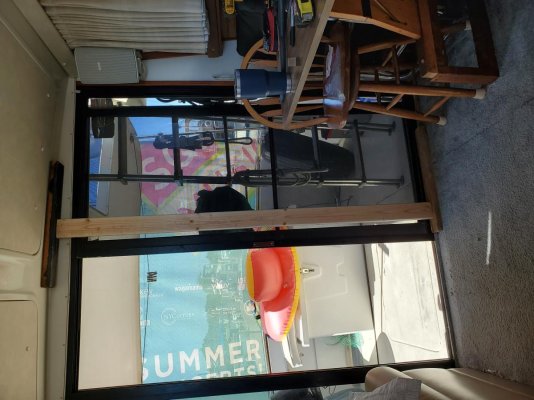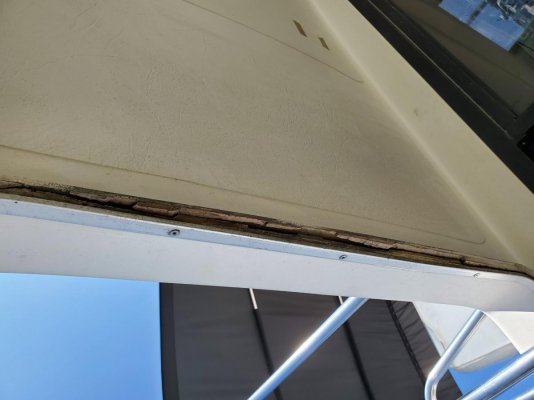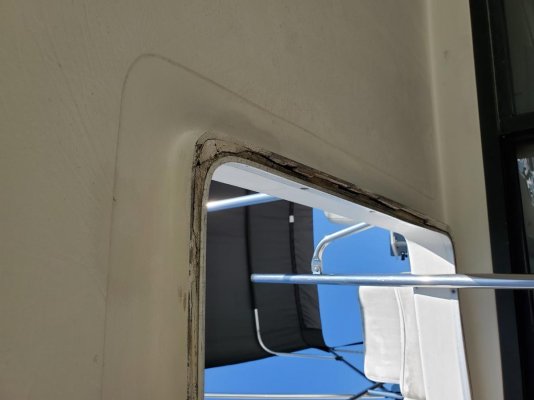John E Holden
Member
- Joined
- Mar 26, 2011
- Messages
- 19
- Location
- USA
- Vessel Name
- John E Holden
- Vessel Make
- 80 Mainship Model 1 Trawler
Folks of older mainships,
I have an 80 mkll the one with the flybridge overhang. Last week I embarked on fixing the rollers on my sliding glass door, only to discover that I had about an inch of deflection at the center of the door frame which seemd to effect the screen door more than the glass door. Which door was effected more was not the issus as much as, I'm sure my issue goes far beyond my simple door fix. Another thing I noticed while I was rolling around on the cockpit floor like a farm animal was that the entire frame is bending from left to right as the boat rolls in the slip. Just a few other points to mention here. As I was sussing out a fuel pickup tube issue this summer, I noticed that the salon floor on the inside of the slider was rotted just where it meets the wall that the slider is attached to. The outside mouldings are also rotted out and it was one of those things that was on my list to repair.
I have since jacked up the ceiling just behind the door and the screen seems happy now but what am I looking at to get this right. Is it possible that the floor above is water logged and putting a boatload (no pun intended) of pressure on the door frame. Or is it just a matter of reframing the door on that wall to get the superstructure to stop swaying in the wind.When I first noticed this I got myself positioned under the floor next to the frame to see if I could move the center of the frame up with my head, and it didnt budge. Only the gentle push of my hydraulic floor jack did what I ultimately needed to get this back to spec.
Now I know I cant be the only one that been bit by this dog but I am open to suggestions on how to solve the said problem. I checked the wood underneath and that looks solid. I am going to grab some pictures this week to show where the current rot is located to possibly shed some light on what I am dealing with. See the attached for my makeshift ceiling support.
I have an 80 mkll the one with the flybridge overhang. Last week I embarked on fixing the rollers on my sliding glass door, only to discover that I had about an inch of deflection at the center of the door frame which seemd to effect the screen door more than the glass door. Which door was effected more was not the issus as much as, I'm sure my issue goes far beyond my simple door fix. Another thing I noticed while I was rolling around on the cockpit floor like a farm animal was that the entire frame is bending from left to right as the boat rolls in the slip. Just a few other points to mention here. As I was sussing out a fuel pickup tube issue this summer, I noticed that the salon floor on the inside of the slider was rotted just where it meets the wall that the slider is attached to. The outside mouldings are also rotted out and it was one of those things that was on my list to repair.
I have since jacked up the ceiling just behind the door and the screen seems happy now but what am I looking at to get this right. Is it possible that the floor above is water logged and putting a boatload (no pun intended) of pressure on the door frame. Or is it just a matter of reframing the door on that wall to get the superstructure to stop swaying in the wind.When I first noticed this I got myself positioned under the floor next to the frame to see if I could move the center of the frame up with my head, and it didnt budge. Only the gentle push of my hydraulic floor jack did what I ultimately needed to get this back to spec.
Now I know I cant be the only one that been bit by this dog but I am open to suggestions on how to solve the said problem. I checked the wood underneath and that looks solid. I am going to grab some pictures this week to show where the current rot is located to possibly shed some light on what I am dealing with. See the attached for my makeshift ceiling support.




